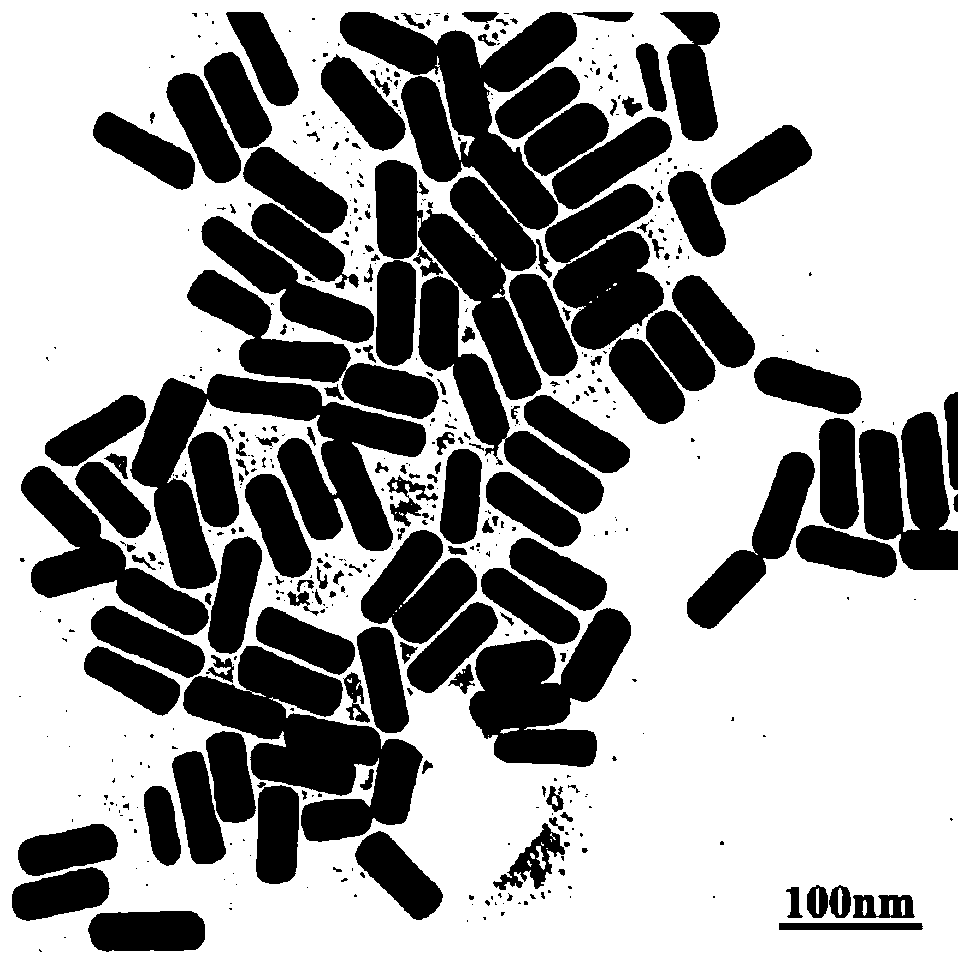A method for constructing dolmen structures based on DNA origami templates and gold nanorods
A nano-gold rod and paper template technology is applied in the field of detection and analysis to achieve the effect of low experimental condition requirements and low cost
- Summary
- Abstract
- Description
- Claims
- Application Information
AI Technical Summary
Problems solved by technology
Method used
Image
Examples
Embodiment 1
[0058] Example 1. Regarding the preparation of nano-gold rods with specific sizes by the seed crystal growth method. Preparation of seed crystals:
[0059] (1) Stir and mix 10mL aqueous solution of cetyltrimethylammonium bromide with a molar concentration of 0.1mol / L and 0.25mL aqueous chloroauric acid solution with a molar concentration of 0.01mol / L, and quickly add 0.6mL of it through an ice-water bath The molar concentration is 0.01mol / L sodium borohydride aqueous solution, vigorously stirred for 2min;
[0060] (2) The mixed solution obtained in step (1) was left to stand at 30° C. for 2 hours to react.
Embodiment 2
[0061] Example 2. Regarding the preparation of specific size nano-gold rod growth solution by seed crystal growth method:
[0062] (1) 40mL molar concentration is 0.1mol / L cetyltrimethylammonium bromide aqueous solution and 2mL molar concentration is 0.01mol / L chloroauric acid aqueous solution mixing, stirs;
[0063] (2) Add 0.3 mL of silver nitrate solution with a molar concentration of 0.01 mol / L and 0.8 mL of a hydrochloric acid solution with a molar concentration of 1 mol / L to the solution in step (1) while stirring at 30° C., and stir for 5 min;
[0064] (3) Add dropwise 0.30ML of ascorbic acid solution with a molar concentration of 0.1mol / L to the solution in step (2) while stirring at 30°C, the solution changes from yellow to colorless rapidly, and stir for 2 minutes;
[0065] (4) Add 0.08 mL of 5-fold seed crystal diluent dropwise to the solution in step (3) while stirring at 30° C., stir for 2 min, and let stand to react for 12 h;
[0066] (5) The solution changes fr...
Embodiment 3
[0068] Example 3, about the preparation of gold nanorods modified by ssDNA1:
[0069] Take 150 μL of gold nanorod solution in Example 2 to prepare ssDNA1-modified gold nanorods:
[0070] (1) Centrifuge and wash 150 μL nano-gold rod solution twice, centrifuge at 4500 rpm for 10 minutes, and disperse the centrifuged product into 100 μL ultrapure water;
[0071] (2) Take 5 μL of 100 μM ssDNA1 and add it to the solution in step (1), and at the same time add 1.5 μL of 1% sodium dodecyl sulfate solution, oscillate and mix, and place it in a 37°C, 250rpm Constant temperature shaker, shake and incubate for 4h;
[0072] (3) Add 2 mol / L sodium chloride solution dropwise to the solution in step (2), add 2.5 μL each time, and add dropwise 4 times at an interval of half an hour. A constant temperature shaker at 250rpm, shaking and incubating for 8h;
[0073] (4) After the reaction in step (3), concentrate the ssDNA1-modified gold nanorods obtained in step (3) by centrifugal purification...
PUM
| Property | Measurement | Unit |
|---|---|---|
| length | aaaaa | aaaaa |
| diameter | aaaaa | aaaaa |
Abstract
Description
Claims
Application Information
 Login to View More
Login to View More - R&D
- Intellectual Property
- Life Sciences
- Materials
- Tech Scout
- Unparalleled Data Quality
- Higher Quality Content
- 60% Fewer Hallucinations
Browse by: Latest US Patents, China's latest patents, Technical Efficacy Thesaurus, Application Domain, Technology Topic, Popular Technical Reports.
© 2025 PatSnap. All rights reserved.Legal|Privacy policy|Modern Slavery Act Transparency Statement|Sitemap|About US| Contact US: help@patsnap.com



